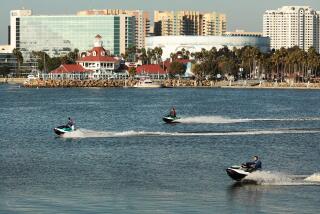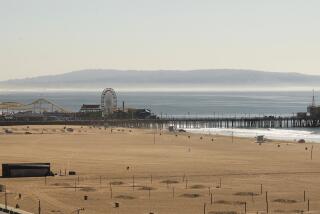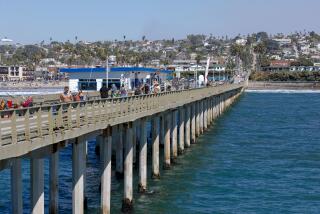Council Keeps Queen Mary in Long Beach
- Share via
Rejecting a potentially lucrative offer by Japanese promoters, the Long Beach City Council voted Tuesday to keep the historic Queen Mary home and look for other ways to finance $32 million in repairs to the ship.
Closing yet another chapter in the often controversial reign of the Queen Mary in Long Beach, the council voted 6 to 3 to deny the request by the ship’s operator, Joseph Prevratil, to tow the 1930s-era luxury- liner-turned-hotel to Tokyo Bay for three to five years.
Although nearly all the nine members of the council indicated months ago that they wanted to keep the ship in Long Beach, where it is an important tourism icon, the promise of a massive infusion of money from Japan was almost too tempting to turn down.
“We have discussed this ad infinitum,” said Mayor Beverly O’Neill, who had been cool to the idea of letting the Queen Mary go since it was proposed in January. “The council felt a decision needed to be made tonight.”
Japanese business interests had promised $40 million to refurbish and outfit the ship for the trans-Pacific voyage, saying they would give the city an additional $5 million for each year the ship was in Tokyo Bay and then send it home with $20 million for future repairs.
But the council sided with City Manager James C. Hankla, who urged members to reject the proposal, contending that the deal was too risky. Hankla questioned whether the financing was as solid as Prevratil indicated and said there were far too many uncertainties.
“The proposed deal was incredibly complex,” Hankla said. “The devil’s always in the details. We think the details are horrendous here.” Among other things, Hankla cited difficulties in negotiating in a foreign language.
One of the biggest problems Prevratil faced was convincing the council that the offer was valid. Several council members complained that he had not provided adequate documentation of commitments from the Japanese.
Prevratil continued to insist that his financial backing was solid. He warned the City Council before the vote that it was taking on a huge obligation in promising to finance the repairs locally.
“The real risk is not approving the Grand Tour,” he said, using the name he gave the proposed voyage to Japan.
In the end, the council authorized Hankla to begin negotiations for the future development of a valuable 45-acre parcel next to the Queen Mary’s anchorage, owned by the city and controlled by Prevratil. Hankla said he thought the property could generate about $4.5 million in income for the city through leases and taxes, which would be earmarked for ship repair.
That left some members of the council angry, arguing that the city was essentially pledging all the revenues it might receive from one of the city’s last remaining undeveloped waterfront parcels.
“We are basically converting 45 acres of key waterfront land only for the preservation of the Queen Mary,” said City Councilman Doug Drummond, who voted with council members H. Delano Roosevelt and Mike Donelon to continue to study the possible move to Japan.
But others jumped at the possibility of financing the ship’s repairs locally.
Councilwoman Jenny Oropeza compared the debate to a slow death by water torture. “None of us were dying to send the Queen Mary to Tokyo,” she said. She said Hankla’s proposal, admittedly based on “a ballpark estimate” of potential development dollars, was worth pursuing.
“The best thing we can do is send a clear and strong message that the Queen isn’t going anywhere,” said Councilman Jerry Shultz.
More to Read
Sign up for Essential California
The most important California stories and recommendations in your inbox every morning.
You may occasionally receive promotional content from the Los Angeles Times.









